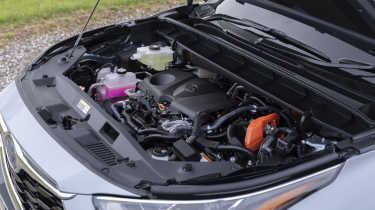‘Show me tell me’ questions: top tips for your driving test
During your driving test, you’ll be asked ‘show me tell me’ questions – here’s what you need to know

The ‘show me, tell me’ questions are a part of every practical driving test. They’re designed to assess the candidate’s knowledge of basic safety and maintenance aspects of the car, from how to check the oil level, to using the windscreen washer while on the move.
While there are many different questions for the examiner to choose from, you’ll only be asked one ‘show me’ and one ‘tell me’ question during your driving test. Getting a question wrong isn’t an instant fail, but it will count as a minor fault, so it’s best to practise your answers in advance to feel confident on test day.
 Practical driving test tips: how to get your driving licence
Practical driving test tips: how to get your driving licence
This guide covers everything you need to know about the 'Show me, tell me' portion of the practical driving test, with common questions and expert advice on how to answer them.
What are the ‘show me, tell me’ questions?
‘Show me, tell me’ questions are designed to test your knowledge of car safety and maintenance, as well as how to operate key controls while on the move.
Your driving test will begin with a ‘tell me’ question, in which you’ll be required to describe how you’d carry out a safety or maintenance task. In most cases, a verbal answer is all that’s needed, but sometimes you’ll need to physically locate a maintenance feature, such as the oil dipstick under the bonnet.

Later during your driving test you’ll be asked a ‘show me’ question. This will require you to use one of the car’s basic features while driving, such as rolling up or down your window or turning on the window demister. The examiner will be watching to make sure you’re not only able to perform this task, but that you can do so safely without getting distracted from the road ahead.
Below are examples of different ‘Show me, tell me’ questions that you might be asked on your driving test, along with our experts’ answers.
‘Tell me’ questions
At the beginning of your test, the examiner will ask you to read the number plate of a nearby car to test your eyesight. Before you set off, you will then be asked a ‘tell me’ question which is designed to test your knowledge of how to carry out a safety or maintenance task.
In this section you’ll only be required to tell the examiner how to perform the task verbally, but for questions 12, 13 and 14 you’ll also need to open the bonnet and point out certain areas of the engine.
1. Tell me where you’d find the information for the recommended tyre pressures for this car and how tyre pressures should be checked.
You’ll find the tyre pressure information in the car’s manual. You should use a reliable pressure gauge making sure to check and adjust the pressures while the tyres are cold. Don’t forget to check the spare tyre if the car has one and remember to refit the valve caps.
2. Tell me how you make sure your head restraint is correctly adjusted so it provides the best protection in the event of a crash.
The head restraint should be adjusted so the rigid part of the head restraint is at least as high as the eye or top of the ears, and as close to the back of the head as is comfortable. Note: Some restraints might not be adjustable.
3. Tell me how you’d check the tyres to ensure that they have sufficient tread depth and that their general condition is safe to use on the road.
Check that the tyres have no cuts or bulges. There should be at least 1.6mm of tread depth across the central three-quarters of the breadth of the tyre, and around the entire outer circumference of the tyre.
4. Tell me how you’d check that the headlights and tail-lights are working. You don’t need to exit the vehicle.
You should operate the headlight switch, turning on the ignition if necessary. Then you should walk around the vehicle. (as this is a ‘tell me’ question, you don’t need to physically check the lights, just describe the process).
5. Tell me how you’d check that the brakes are working before starting a journey.
The brakes should not feel spongy or slack and should be tested as you set off. The vehicle should not pull to one side when braking.
6. Tell me how you’d know if there was a problem with your anti-lock braking system.
A warning light should illuminate on the gauge cluster if there is a fault with the anti-lock braking system.
7. Tell me how you’d check the direction indicators are working. You don’t need to exit the vehicle.
You should operate the hazard indicator switch, turning on the ignition if necessary. Then you should walk around the vehicle. (as this is a ‘tell me’ question, you don’t need to physically check the lights).
8. Tell me how you’d check the brake lights are working on this car.
You should operate the brake pedal and ask someone to check that the brake lights are illuminating. If you have no one to help, make use of reflections in nearby vehicles, windows or doors, instead.
9. Tell me how you’d switch on the rear fog light(s) and explain when you’d use it/them. You don’t need to exit the vehicle.
You should operate the fog light switch (turn on dipped headlights and ignition if necessary). Then you should check the warning light on the gauge cluster is on, indicating they are working. Fog lights should only be used when you can only see a distance of 100 metres.
10. Tell me how you switch your headlight from dipped to main beam and explain how you’d know the main beam is on.
You should operate the switch, turning on the ignition or engine if necessary (most cars switch from dipped beam to main beam by pulling or pushing the stalk). To check your main beam is working, look for the blue main beam warning light on the gauge cluster.
11. Tell me how you’d check the power-assisted steering is working before starting a journey.
If the steering becomes heavy, the system may not be working properly. Before starting a journey, 2 simple checks can be made: Gentle pressure on the steering wheel, maintained while the engine is started, should result in a slight but noticeable movement as the system begins to operate. Alternatively, turning the steering wheel just after moving off will give an immediate indication that the power assistance is functioning.
12. Open the bonnet and tell me how you’d check that the engine has sufficient oil.
Identify the dipstick/oil level indicator and describe how the oil level should sit between the minimum and maximum markers.
13. Open the bonnet and tell me how you’d check that the engine has sufficient engine coolant.
Identify the high and low level markings on the header tank where fitted or the radiator filler cap. Describe how to top up to the correct level between the high and low markings.
14. Open the bonnet and tell me how you’d check that you have a safe level of hydraulic brake fluid.
Identify the reservoir and check the level against high and low markings.
‘Show me’ questions
During the test, you’ll be asked to physically demonstrate your answer to one ‘show me’ question while driving. There are only seven of these to learn, and you’ll be asked simple things like how to wash and clean the front windscreen, or how to turn on the headlights. Once again, your instructor should make sure you’ve covered all these things in the course of your lessons.
Here are the ‘show me’ questions you could be asked:
1. When it’s safe to do so, can you show me how you wash and clean the front windscreen?
2. When it’s safe to do so, can you show me how you’d switch on your dipped headlights?
3. When it’s safe to do so, can you show me how you wash and clean the rear windscreen?
4. When it’s safe to do so, can you show me how you’d operate the horn?
5. When it’s safe to do so, can you show me how you’d demist the front windscreen?
6. When it’s safe to do so, can you show me how you’d set the rear demister?
7. When it’s safe to do so, can you show me how you’d open and close the side window?
What if I get the answer wrong?
Fortunately, you won’t fail instantly if you get an answer wrong – a wrong answer is recorded as a ‘minor’ fault. Throughout the whole driving test, you can make up to 15 minor faults and still pass.
This whole section is over pretty quickly. The key is to listen carefully to what the examiner is asking you and if you’re unclear, ask them to repeat it.
Now you know about the ‘show me, tell me’ questions, check out our guide to the hazard perception test and the theory test…
Recommended

Beat the Easter weekend traffic: secrets of a stress-free car getaway
Most Popular
Tips & advice

Car dashboard warning lights: what does each symbol mean?

Electric car charging stations: public networks, charger types, apps and maps







